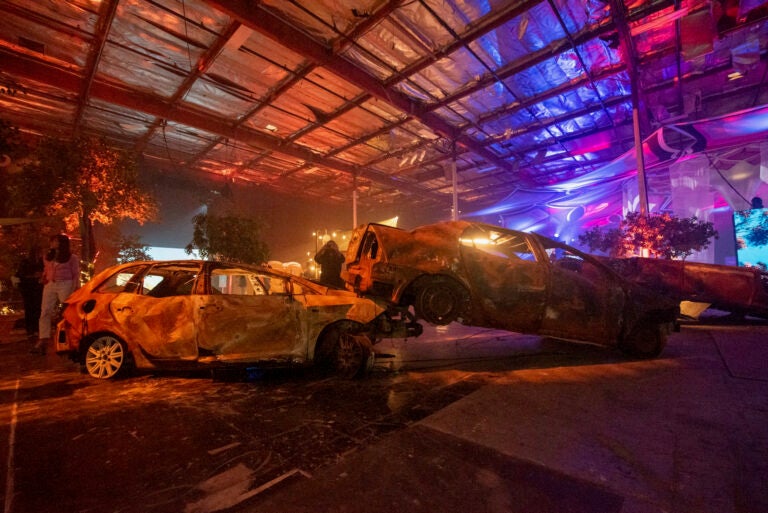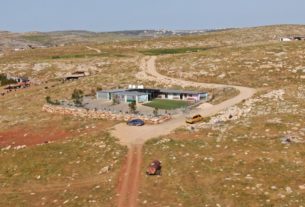(New York Jewish Week) — To celebrate the end of his two years of service as a medic in the Israel Defense Forces’ paratrooper division, Tomer Meir joined 13 of his friends at the Nova Musica Festival on the weekend of October 6 in Re’im in southern Israel.
It was his first ever music festival. “It was the best moments of my life. I can’t explain the state we were in,” the 21-year-old told the New York Jewish Week. “It was pure love — people dancing, laughing, smiling. All the good stuff that we’re living for.”
Until 6:29 a.m. on Saturday morning. The red alerts, the rockets and the running.
“The music stopped. The rockets started. We started running for our lives,” Meir said. Meir is a survivor of the Nova Music Festival Massacre, where Hamas militants killed 364 festival-goers and took at least 40 hotstages on the morning of Oct. 7.
Six months after the attack, Meir is in New York sharing his story as part of an interactive exhibit about that day, which he says is helping him heal.
“As a survivor, the healing that we are doing together as a community is what is really healing for me,” Meir said. “To heal each other — this is Nova.”
The Nova Musical Festival exhibition, titled “October 7th, 06:29AM,” is an immersive step into what it was like to be at the festival when it was attacked.
Screens show clips from the attack on Nova are displayed next to personal and camping items taken from the festival recreating the festival layout at “The Nova Music Festival Exhibition: October 7th 06:29 AM, The Moment Music Stood Still.” (Alexi Rosenfeld/Getty Images for The Nova Music Festival Exhibition)
The exhibit, which debuted in Tel Aviv for 10 weeks in December, was created by Israeli designers and cultural producers, many of whom were producers with the Nova Music Festival itself. It was brought to New York with the help of Scooter Braun, the Jewish-American music producer and philanthropist.
Like the Tel Aviv version, the exhibit recreates the visuals and sounds of the Nova Music Festival massacre. But the New York version is in some ways “more intense,” according to Yael Finkelstein, a volunteer who collected items from the Nova site and helped set up both the Tel Aviv and New York exhibit.
“In Israel, we did this very fast after the 7th of October, so we don’t want to cause pain to people,” said Omri Sassi, one of the exhibit’s producers, who was also a DJ at the festival and founder of the Nova community. But in New York, he said, “We needed to show to people from out of the country what happened.”
New elements at the New York exhibit include dozens of video testimonies from survivors, Zaka volunteers and family members, as well as graphic raw footage taken on Oct. 7 from both festival-goers and Hamas militants. In addition, survivors of the massacre such as Meir and Sassi will be at the exhibit every day to share their stories and answer questions.
Their goal, Meir said, is to show New Yorkers that the horror they experienced could happen to anyone.
Support the New York Jewish Week
Our nonprofit newsroom depends on readers like you. Make a donation now to support independent Jewish journalism in New York.
“It could be your kids, your mother, your sister or brother. It could be anyone — if you want your children to have a time to celebrate life like was I celebrating, first you have to come see what happened to us,” said Meir.
They also want to offer a respite from tensions over the Israel-Hamas war, which began with the Oct. 7 attack. Some Israelis, including Nova survivors, who have traveled to the United States to tell their stories have faced protests from pro-Palestinian advocates who see them as advancing propaganda to benefit Israel’s war effort.
That perception is misguided, Yoni Feingold, another one of the exhibit’s creators, told the New York Jewish Week.
“The first thing that everybody should understand is this was an international music festival, a language of the whole world,” Feingold said. “Our goal is to separate the idea that this international music festival was on the Israeli side of the conflict. We’re not talking about politics, we’re not talking about the conflict — this is about a music festival.”
He noted that the exhibit was premiering during Coachella, one of the biggest music festivals in the United States, held in California.
“Any young person that goes to Coachella this weekend should relate to an innocent music festival that was attacked viciously when the whole goal was to spread love and peace and acceptance of everybody,” said Feingold, who is the chairman of the Association of Cultural and Performing Arts in Israel. His wife, Reut, is the curator and director of the exhibition.
Before entering the exhibit, guests watch a short documentary about the culture of the “Tribe of Nova,” the festival billed as a celebration of “friends, love and infinite freedom” that centered on “trance music,” a genre of electronic dance music, which helps attendees understand the energy of love, joy and music that Nova festival-goers brought to the experience before terror struck.
After learning about the Nova ethos, guests enter the exhibit, tiptoeing around remnants of campsites, while dozens of screens simultaneously play videos taken on the morning of Oct. 7 The effect is loud and alarming, meant to place each guest in the exact moments of chaos, tension and fear that coursed through the festival grounds. (Producers of the exhibition recommend that children under 16 not attend the exhibit.)
In other screens scattered throughout the rooms, the exhibit features video testimony from dozens of survivors of the festival, each sharing what drew them to Nova and how they escaped. In one section, volunteers from Zaka, the first responder search and rescue service in Israel, describe the horror and mutilation that they saw when they arrived at the Nova festival site on Oct. 7 and in the weeks after. Another section allows guests to step into a recreation of the concrete bunkers many of the victims piled into to protect themselves.

Hundreds of shoes were left behind at the festival site. Volunteers spent weeks collecting, photographing and cataloguing the items. (Julia Gergely)
Everything in the exhibit was brought in directly from the Nova site, Feingold said. That includes the dirt on the ground, lawn chairs, blankets, burned cars, porta-potties pockmarked with bullet holes, the DJ equipment and stage.
A massive “Lost & Found” section fills a corner of the 50,000 square-foot space. Clothing, kippot, backpacks, flasks, books, hats, shoes and watches that were left behind that morning are set up on tables. Each item was collected by volunteers at the Nova site, who also photographed everything so survivors and family members may be reunited with their belongings if they see something they recognize.
Before the exhibit concludes, guests can view a memorial with photos of the 364 victims killed during the massacre, and a wall dedicated to the approximately 250 hostages kidnapped from Re’im and nearby areas that day.
Support the New York Jewish Week
Our nonprofit newsroom depends on readers like you. Make a donation now to support independent Jewish journalism in New York.

A pile of kippot found at the festival site. (Julia Gergely)
The exhibit is open at 23 Wall Street in New York from April 21 to May 25. Timed-entry tickets are minimum $1, though guests have the option to purchase a ticket for $18, $36, $72 or $180, with the ticket cost donated to the Nova Healing Journey, an initiative supporting therapy and other mental health treatments for Oct. 7 survivors and their families.
As in the Tel Aviv exhibit, each room gets brighter as guests walk through, ending in a warm, light-filled “healing space” with couches and coloring books. One wall is adorned with the slogan of hope that has taken off since the days immediately after the attack.
“We will dance again,” the wall promises.
“The journey to heal yourself is a journey, for sure. Part of the community of Nova is that we heal each other together — healing is to help take care of others,” said Meir. “For me Nova is hope, helping each other, always smiling and taking care of each other. I wish to spread that hope all my life.”




